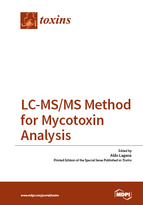LC-MS/MS Method for Mycotoxin Analysis
A special issue of Toxins (ISSN 2072-6651). This special issue belongs to the section "Mycotoxins".
Deadline for manuscript submissions: closed (15 October 2016) | Viewed by 82993
Special Issue Editor
Special Issue Information
Dear Colleagues,
Various filamentous fungi can produce secondary metabolites that have no biochemical significance in fungal growth and development; however, some of these metabolites can cause deleterious effects on other organisms and are classified as mycotoxins. The main mycotoxin-producing fungi belong to species of Fusarium, Aspergillus, Penicillium, Claviceps and Alternaria genera. Mostly, human exposure to mycotoxins occurs through the intake of contaminated agricultural products or indirectly through the intake of residues or metabolite products present in foods of animal origin. Seldom, exposure may also occur through dermal contact and inhalation. About 400 mycotoxins belonging to heterogeneous chemical classes are known, and they can exert very diverse toxic effects (e.g., cancerogenic and immunosuppressive effects). The most known are aflatoxins, ochratoxin, trichothecenes A and B, fumonisins, and macrocyclic lactones.
Immunochemical methods (such as ELISA) can be used for rapid screening of mycotoxin presence, however, for confirmation purpose, analytical methods based on high performance liquid chromatography (LC) are preferred, especially when coupled with tandem mass spectrometry (MS/MS), which allows to determine multiclass mycotoxins in a single analysis.
This Special Issue aims to collect papers describing development or application of LC-MS/MS-based methods for the analysis of mycotoxins in various matrices, with attention also on sample preparation step. We welcome both research or review articles proposing novelties or overview, respectively, on this topic
Prof. Dr. Aldo Laganà
Guest Editor
Manuscript Submission Information
Manuscripts should be submitted online at www.mdpi.com by registering and logging in to this website. Once you are registered, click here to go to the submission form. Manuscripts can be submitted until the deadline. All submissions that pass pre-check are peer-reviewed. Accepted papers will be published continuously in the journal (as soon as accepted) and will be listed together on the special issue website. Research articles, review articles as well as short communications are invited. For planned papers, a title and short abstract (about 100 words) can be sent to the Editorial Office for announcement on this website.
Submitted manuscripts should not have been published previously, nor be under consideration for publication elsewhere (except conference proceedings papers). All manuscripts are thoroughly refereed through a double-blind peer-review process. A guide for authors and other relevant information for submission of manuscripts is available on the Instructions for Authors page. Toxins is an international peer-reviewed open access monthly journal published by MDPI.
Please visit the Instructions for Authors page before submitting a manuscript. The Article Processing Charge (APC) for publication in this open access journal is 2700 CHF (Swiss Francs). Submitted papers should be well formatted and use good English. Authors may use MDPI's English editing service prior to publication or during author revisions.
Keywords
- mycotoxins
- fungi
- molds (moulds)
- extraction
- multiresidue determination
- liquid chromatography
- mass spectrometry
- Fusarium
- Aspergillus







